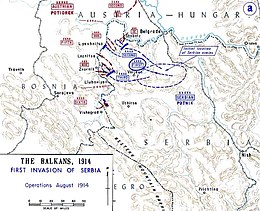Battle of Cer
| Battle of Cer | |||||||
|---|---|---|---|---|---|---|---|
| Part of the Serbian Campaign of the Balkans Theatre of the First World War | |||||||
 A map depicting the initial Austro-Hungarian invasion of Serbia, August 1914. |
|||||||
|
|||||||
| Belligerents | |||||||
|
|
|
||||||
| Commanders and leaders | |||||||
| Oskar Potiorek | |||||||
| Units involved | |||||||
| Strength | |||||||
| ~200,000 soldiers | ~180,000 soldiers | ||||||
| Casualties and losses | |||||||
|
|
||||||
The Battle of Cer was fought between Austria-Hungary and Serbia in August 1914 during the early stages of the Serbian Campaign of the First World War. It took place around Cer Mountain and several surrounding villages, as well as the town of Šabac.
The battle, part of the first Austro-Hungarian invasion of Serbia, began on the night of 15 August when elements of the Serbian 1st Combined Division encountered Austro-Hungarian outposts that had been established on the slopes of Cer Mountain earlier in the invasion. The clashes that followed escalated into a battle for control over several towns and villages near the mountain, especially Šabac. On 19 August, the morale of the Austro-Hungarians collapsed and thousands of soldiers retreated back into Austria-Hungary, many of them drowning in the Drina River as they fled in panic. On 24 August the Serbs re-entered Šabac, marking the end of the battle. Serbian casualties after nearly ten days of fighting were 3,000–5,000 killed and 15,000 wounded. Those of the Austro-Hungarians were significantly higher, with 6,000–10,000 soldiers killed, 30,000 wounded and 4,500 taken as prisoners of war. The Serb victory over the Austro-Hungarians marked the first Allied victory over the Central Powers in the First World War, and the first aerial dogfight of the war took place during the battle.
Relations between Austria-Hungary and Serbia deteriorated in the aftermath of the May Overthrow in 1903. Almost immediately, the new Karađorđević government aligned itself with the Russian Empire and oriented its foreign policy away from its long time patron, the Habsburgs, and Austria-Hungary. In 1906, Austria-Hungary closed its border to Serbian agricultural exports in an episode known as the Pig War. In 1908, Austria-Hungary formally annexed Bosnia-Herzegovina—a territory with a large Serb population that it had been granted by the Congress of Berlin in 1878. The annexation prompted the Serbian public to call for war with Austria-Hungary. With no promise of Russian support in the event of war, the Serbian government decided against pursuing the matter militarily.Count Franz Conrad von Hötzendorf boasted that it would take Austro-Hungary only three months to defeat Serbia should war erupt between the two nations.
...
Wikipedia
